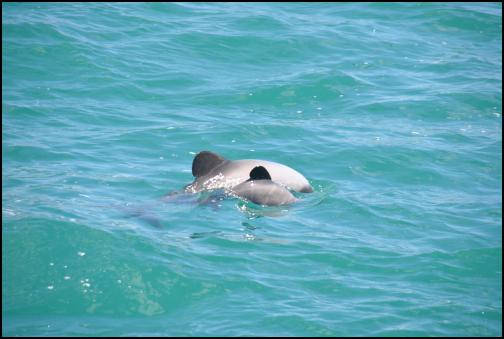Rare dolphin calves sighted in Akaroa Harbour

Rare
dolphin calves sighted in Akaroa Harbour
Survival of
the species
17 December 2014
Rare dolphin calves have been sighted in Akaroa Harbour, which is always great news for the endangered species.
Early summer has seen Hector's dolphin calves spotted swimming with their mothers in the harbour, which is always exciting, Black Cat Cruises Sales & Marketing Manager Natasha Lombart said.
"Hector's Dolphins are classified as endangered by the World Conservation Union (IUCN). Because of their coastal habitat and slow reproductive rate they are particularly vulnerable to entanglement in fishing gear, especially gill nets, so we never fail to get enthusiastic when calves are spotted.”
Black Cat Cruises skipper Julian Yates said two Hector dolphin mothers and their calves were seen between Bush Bay and the salmon farm, half way across the bay in Akaroa Harbour.
“That there were two babies’ with two mums was just fantastic,” he said. “They were just cruising and the guest reactions on board were great – they were so excited to see such a rare species of new born babies, it was wonder, a real treat and so delightful.”
Yates said guests on the harbour cruise could clearly see the calves' stripes from being folded up inside mother's tummy as they able to swim as soon as they are born.
Females usually have one calf every two to three years. The calves are 50 to 60 centimetres long at birth and stay close to their mothers who provide them with milk and protection for about a year until they are old enough to fend for themselves.
Hector's dolphins are among the most endangered in the world.
It has been an eventful week for Black Cat Cruises as a female Orca and her two claves were seen playing with a pod of Hector’s dolphins near the entrance to Akaroa Harbour last week.
Yates said it was extremely rare to see Orca’s interacting with Hector’s as Orcas are known for preying on dolphins.
Ends


 Hugh Grant: How To Reduce Network Bottlenecks
Hugh Grant: How To Reduce Network Bottlenecks Dominion Road Business Association: Auckland Transport's 'Bus To The Mall' Campaign: A Misuse Of Public Funds And A Blow To Local Businesses
Dominion Road Business Association: Auckland Transport's 'Bus To The Mall' Campaign: A Misuse Of Public Funds And A Blow To Local Businesses Parrot Analytics: A Very Parrot Analytics Christmas, 2024 Edition
Parrot Analytics: A Very Parrot Analytics Christmas, 2024 Edition Financial Markets Authority: Individual Pleads Guilty To Insider Trading Charges
Financial Markets Authority: Individual Pleads Guilty To Insider Trading Charges Great Journeys New Zealand: Travel Down Memory Lane With The Return Of The Southerner
Great Journeys New Zealand: Travel Down Memory Lane With The Return Of The Southerner WorkSafe NZ: Overhead Power Lines Spark Safety Call
WorkSafe NZ: Overhead Power Lines Spark Safety Call



